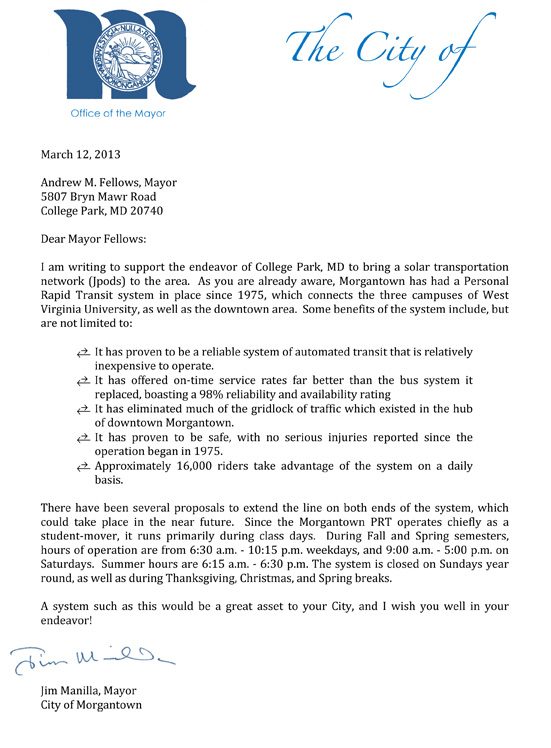4 Steps to Implement Solar-powered transport networks
- Agree to the #5x5Solar standard. Privately funded transport networks 5 times more efficient than roads (>125 mpg) pay 5% of gross transport revenues to use airspace over approved public Rights of Way with safety regulated by Texas Department of Insurance.
- Maintenance Facility to stage deployment:
- Funded and built by JPods.
- Rights of Way access in compliance with TXDOT.
- Certified operational by Texas Department of Insurance.

- If any requirement fails, JPods pays to remove all components that are above grade.
- Expand the networks between Car Rental and agreed to terminal locations.
- Expand beyond the airport to provide airport access as mutually agreed to by the associated governments and other entities.
Congressional Study PB-244854, Automated Guideway Transit
The barrier to transport network innovation is regulatory.
The same barrier was experienced in communications networks. Timeline:
- 1918: President Wilson monopolized communications by Executive Order locking in the existing analog networks and rotary telephones.
- 1926: interview with Collier’s magazine: Nikola Tesla, “When wireless is perfectly applied the whole earth will be converted into a huge brain, …. We shall be able to communicate with one another instantly, irrespective of distance. Not only this, but through television…. A man will be able to carry one in his vest pocket.“
- 1927: First video phone call.
- 1942: Hedy Lamarr patented the technologies for WiFi and BlueTooth.
- 1968: Mother of All Demos documents most aspects of the Internet and modern computing. Start at minute 30 for 4 minutes to watch the “mouse”, video conferencing, clicking on URLs, etc….
- 1973: Cell phones were available.
- 1982: Federal courts declared the Federal communications monopoly unconstitutional and initiated a multi-year de-monopolization plan. Rotary dial telephones were still very common but being displaced by “touch-tone” phones.
- 1985: AppleTalk was released.
- 1994: Today Show, “Alison, what is the Internet any way” marks wide spread public awareness of the digitizing of communications.
- 2007: Apple introduced the iPhone. This was the first digital phone on digital networks. SmartPhones amplified the Internet by 10X.
Timeline for grade-separated and grade-controlled transportation networks:
- 1865-1869: Grade-controlled Transcontinental Railroad was built (1,911 miles) reducing cost to travel from New York from $1,000 to $76.
- 1865-1912 250,000 miles of railroads were built. Freight railroads average 470 ton-mpg.
- 1901: Wuppertal, grade-separated, suspended bus system defines cleaner, faster, safer, and affordable transport networks.
- 1893: Grade-separated theme park rides set radically higher standards for safety.
- 1930-1970: 110,000 miles of railroads driven out of business by subsidized highways.
- 1956: Federal grade-controlled/separated Interstate Highway networks was started.
- 1972: President Nixon sent his daughter to open the first grade-separated network of self-driving cars, the Morgantown PRT.
- waiting for Rights of Way access to be restored to free markets
This 4-Step process incrementally and safely breaks a century of "institutional failures" as documented by Congressional Study PB-244854, Automated Guideway Transit.
This study was published in 1975 to identify solutions to the 1973 Oil Embargo and traffic problems at that time.
Findings: Government “institutional failures” blocked urban transportation innovation for “four to six decades (aside from some relatively minor cosmetic changes)… Compared with many other areas of entrepreneurial endeavor, the environment for innovation in transportation should be favorable. Urban transportation needs are extensive… In retrospect, the new systems efforts have served not to stimulate interest in new technology but to discourage already reluctant local transit operators from considering it.”
“Proponents of PRT view this concept as a reasonable supplement to the private automobile in high density urban areas and claim that PRT can provide a very much higher level of service than other modes of public transportation. Thus, it is argued that PRT systems would attract a significant percentage of the rides now being made in private automobiles and offer obvious benefits:
- less traffic congestion in urban areas.
- less land and fewer facilities used for automobile storage. . reduced travel time under more comfortable Circumstance. . less noise and air pollution.
- reduction in consumption of petroleum-derived fuels.
- reduction in requirements for new arterial roads and urban freeways.
It is contended that PRT would provide greater mobility for the transportation disadvantaged, i.e., the young, the elderly, the poor, and the handicapped.”.

Experience of PRT Networks
President Nixon sent his daughter, Tricia, to open the world’s first electrically powered, grade-separated network of self-driving cars in Oct, 1972. Walter Cronkite opened the news coverage with, “One of the big problems in this country is something many of us run into every day, traffic jams.” Tricia Nixon said it was “more fun than Disneyland.”
It was part of his plan for the environment and energy. He would later state the objective, “At the end of this decade, in the year 1980, the United States will not be dependent on any other country for the energy we need. We will hold our future in our hands alone.”
President Nixon sent his daughter, Tricia, to open the world’s first electrically powered, grade-separated network of self-driving cars in Oct, 1972. Walter Cronkite opened the news coverage with, “One of the big problems in this country is something many of us run into every day, traffic jams.” Tricia Nixon said it was “more fun than Disneyland.”
It was part of his plan for the environment and energy. He would later state the objective, “At the end of this decade, in the year 1980, the United States will not be dependent on any other country for the energy we need. We will hold our future in our hands alone.”
This network is still operating today with outstanding success as noted by the Mayor of Morgantown in this 2013 letter:




